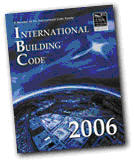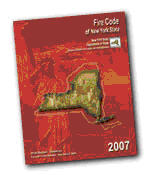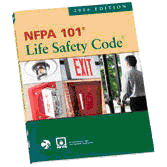
Building codes can be defined as "Regulations governing building design and construction, established by regulatory authorities. Building codes are promulgated and administered by various levels of government, and originate also from a number of quasi-governmental and private organizations."1
"The basis of building code development is to safeguard the health, safety and welfare of the public. Model codes have no force of law unto themselves. Only after adoption by a governmental agency are they enforceable…"2 Each state in the United States has a separate and distinct code adoption process. Many states have adopted various International Codes, but some states have their own building codes. New York State has adopted the 2003 edition of the International Building Code.
The New York State Library has a collection of current and older editions of the International Codes, national model codes and New York State building codes. For more information on NYSL holdings, call the Reference Desk at 518-474-5355 or send an email to refserv@nysed.gov.
The International Code Council (ICC) was established in 1994 as a nonprofit organization dedicated to developing a single set of comprehensive and coordinated national model construction codes. The founders of the ICC are the Building Officials and Code Administrators International, Inc. (BOCA), the International Conference of Building Officials (ICBO) and the Southern Building Code Congress International, Inc. (SBCCI).
The three model codes, the BOCA National Building Code, the Uniform Building Code and the Southern Building Code, were reformatted into a common format. The requirements in each model code for similar design situations were compared. After numerous drafts, multiyear reviews by the model code agencies and code users, and public hearings, the ICC published a single model code in 2000. The International Codes are "kept up to date through the review of proposed changes submitted by code enforcing officials, industry representatives, design professionals and other interested parties." 3 New editions of the International Codes will be published at regular intervals, usually every three years.
The ICC also publishes volumes of Commentary that supplement the International Codes. Each volume of Commentary provides basic knowledge and facts relating to a particular Code and is meant to be used in conjunction with that Code. The Commentary includes a statement of the objective and intent for each section of the Code and usually includes a discussion about why that requirement commands the conditions set forth in the Code.
| Title | NYSL Call Number |
|---|---|
| ICC Electrical Code. Administrative Provisions. | R 602.18, qI612, 206-643, 2006 |
| ICC Performance Code for Buildings and Facilities | R 602.18, qI612, 206-677, 2006 |
| International Building Code | R 602.18, qI612, 200-431, 2006 |
| International Building Code Commentary | R 602.18, qI612, 206-701, 2006 |
| International Energy Conservation Code | R 602.18, qI612, 206-644, 2006 |
| International Energy Conservation Code Commentary | R 602.18, qI612, 206-709, 2003 |
| International Existing Building Code | R 602.18, qI612, 206-665, 2006 |
| International Existing Building Code Commentary | R 602.18, qI612, 206-674, 2006 |
| International Fire Code | R 602.18, qI612, 206-648, 2006 |
| International Fire Code Commentary | R 602.18, qI612, 206-678, 2006 |
| International Fuel Gas Code | R 602.18, qI612, 206-651, 2006 |
| International Fuel Gas Code Commentary | R 602.18, qI612, 206-705, 2006 |
| International Mechanical Code | R 602.18, qI612, 206-642, 2006 |
| International Mechanical Code Commentary | R 602.18, qI612, 206-713, 2006 |
| International Plumbing Code | R 602.18, qI612, 204-1255, 2006 |
| International Plumbing Code Commentary | R 602.18, qI612, 206-670, 2006 |
| International Private Sewage Disposal Code | R 602.18, qI612, 206-650, 2006 |
| International Property Maintenance Code | R 602.18, qI612, 206-646, 2006 |
| International Property Maintenance Code Commentary | R 602.18, qI612, 206-660, 2006 |
| International Residential Code for One- and Two-Family Dwellings | R 602.18, qI612, 203-12776, 2006 |
| International Residential Code for One- and Two-Family Dwellings Commentary | R 602.18, qI612, 206-717, 2006 |
| International Urban-Wildland Interface Code | R 602.18, qI612, 206-669, 2006 |
| International Zoning Code | R 602.18, qI612, 206-647, 2006 |
| Supplement to the International Codes | R 602.18, qI612, 206-673, 2007 |
For more information on International Codes, contact the International Code Council at:
International Code Council
5203 Leesburg Pike, Suite 600,
Falls Church, VA 22041-3401
Telephone: 1-888-ICC-SAFE (422-7233)
E-mail: webmaster@iccsafe.org
Website: http://www.iccsafe.org

"Beginning in the late 1940's, New York State began developing a code known as the State Building Construction Code, which provided standards for the construction of buildings and installation of equipment therein. Developing and maintaining the State Building Construction Code eventually became the responsibility of the New York State Division of Housing and Community Renewal (DHCR). In the 1960's, DHCR began developing a second code, the State Building Conservation and Fire Prevention Code, to address fire safety practices in buildings. Both of these codes were applicable in a municipality only when affirmatively adopted by the governing body."4 ("The decision as to whether to adopt and enforce a building and/or fire prevention code had been left to the discretion of local governments in New York State."4)
"In 1978, the State Legislature added Article 11 to the Energy Law to provide for a comprehensive energy conservation construction code applicable to all public and private buildings in New York State (including buildings located in the City of New York)."4 "In 1981, the New York State Legislature enacted legislation directing the development and implementation of an integrated building and fire code for the state."4 "The New York State Uniform Fire Prevention and Building Code (Uniform Code) took effect January 1, 1984 and prescribed minimum standards for both fire prevention and building construction. It is applicable in every municipality of the state, except for the City of New York, which was permitted to retain its own code." 4
"Effective January 1, 2003, the Uniform Fire Prevention and Building Code consists of several subunits each based on a model code developed by the International Code Council".4 The subunits are Building Code of New York State, Fire Code of New York State, Fuel Gas Code of New York State, Mechanical Code of New York State, Plumbing Code of New York State, Property Maintenance Code of New York State and Residential Code of New York State. These publications, along with the State Energy Conservation Construction Code, are incorporated by reference in Title 19 of the Official Compilation of Codes, Rules and Regulations of the State of New York (NYCRR). These regulations contain the legally enforceable requirements for construction, fire prevention, energy conservation, plumbing and maintenance of buildings and structures.
Current New York State codes combine language from the 2003 International Code volumes and New York State modifications developed by the State Fire Prevention and Building Council and the Department of State's Administrative Task Group. In adapting the International Codes for use by the State of New York, certain sections, tables and figures were deleted and certain new text was added. These changes were intended to remove certain information not applicable within New York State, conform with statutory requirements of the Uniform Code Act and other legislation, and incorporate New York initiatives into the code.
The New York State Library has current and older editions of the New York State building and construction codes. Listed below are the current editions of the New York State codes available at the New York State Library. Many of the older building and construction codes have been digitized and made available through the Library's Digital collections.
The Library holds three copies of the New York State codes listed below.
| Title | NYSL Call Number |
|---|---|
| Building Code of New York State | RR, COD, 200-4, BUICN, 202-5539, 2007 D, COD, 200-4, BUICN, 202-5539, 2007 |
| Energy Conservation Construction Code of New York State | RR, COD, 200-4, ENECC, 202-5542, 2007 D, COD, 200-4, ENECC, 2002-5542, 2007 |
| Existing Building Code of New York State | RR, COD, 200-4, EXIBC, 207-9299 D, COD, 200-4, EXIBC, 2007-9299 |
| Fire Code and Property Maintenance Code of New York State | RR, COD, 200-4, FIRCP, 202-5673, 2007 D, COD, 200-4, FIRCP, 202-5673, 2007, FIRE D, COD, 200-4, FIRCP, 2002-5673, PROPERTY |
| Plumbing Code, Mechanical Code and Fuel Gas Code of New York State | RR, COD, 200-4, PLUCM, 202-5674, 2007 D, COD, 200-4, PLUCM, 202-5674, 2007, PLUMBING D, COD, 200-4, PLUCM, 202-5674, 2007, MECHANIC D, COD, 200-4, PLUCM, 202-5674, 2007, FUEL GAS |
| Residential Code of New York State | RR, COD, 200-4, RESCN, 202-5670, 2007 D, COD, 200-4, RESCN, 2002-5670, 2007 |
For more information on New York State Codes, contact the Division of Code Enforcement and Administration, Department of State at:
New York State Department of State
The New York State Library has a large collection of other current and older construction/building codes and related standards. Listed below is a sample of some of the codes and related standards available in the NYSL collection. (See also Standards and Specifications.) For more information on these items or other standards available at the NYSL, call the Reference Desk at 518-474-5355 or send an email to refserv@nysed.gov.
| Title | NYSL Call Number |
|---|---|
| Accessible and Usable Buildings and Facilities | ANSI/ICC A117.1 |
| ASME Boiler and Pressure Vessel Code | R, 621.184, qA836 |
| Building Code Requirements for Structural Concrete | ACI 318 |
| Code for the Manufacture and Storage of Aerosol Products | NFPA 30B |
| Drinking Water System Components – Health Effects | NSF/ANSI 61 |
| Drinking Water Treatment Chemicals – Health Effects | NSF/ANSI 60 |
| Energy Standard for Buildings Except Low-Rise Residential Buildings | ANSI/ASHRAE/IESNA 90.1 |
| Life Safety Code (NFPA 101) | R, 628.922, qN277, 82-35819, 2006 |
| Minimum Design Loads for Buildings and Other Structures | ASCE/SEI 7 |
| National Electrical Code (NFPA 70) | R, 602.18, qN277, 206-2058 |
| National Electrical Safety Code (IEEE C2) | R, 602.18, qA512, 206-2062 |
| Safety Code for Elevators and Escalators | ANSI A17.1 |
| Seismic Restraint Manual Guidelines for Mechanical Systems |
ANSI/SMACNA 1 |
| Sheet Metal Welding Code | ANSI/AWS D9.1 |
| Standard for Electrical Safety in the Workplace | NFPA 70E |
| Structural Welding Code – Steel | ANSI/AWS D1.1 |
| Thermal Environmental Conditions for Human Occupancy | ANSI/ASHRAE 55 |
| Ventilation for Acceptable Indoor Air Quality | ANSI/ASHRAE 62.1 |